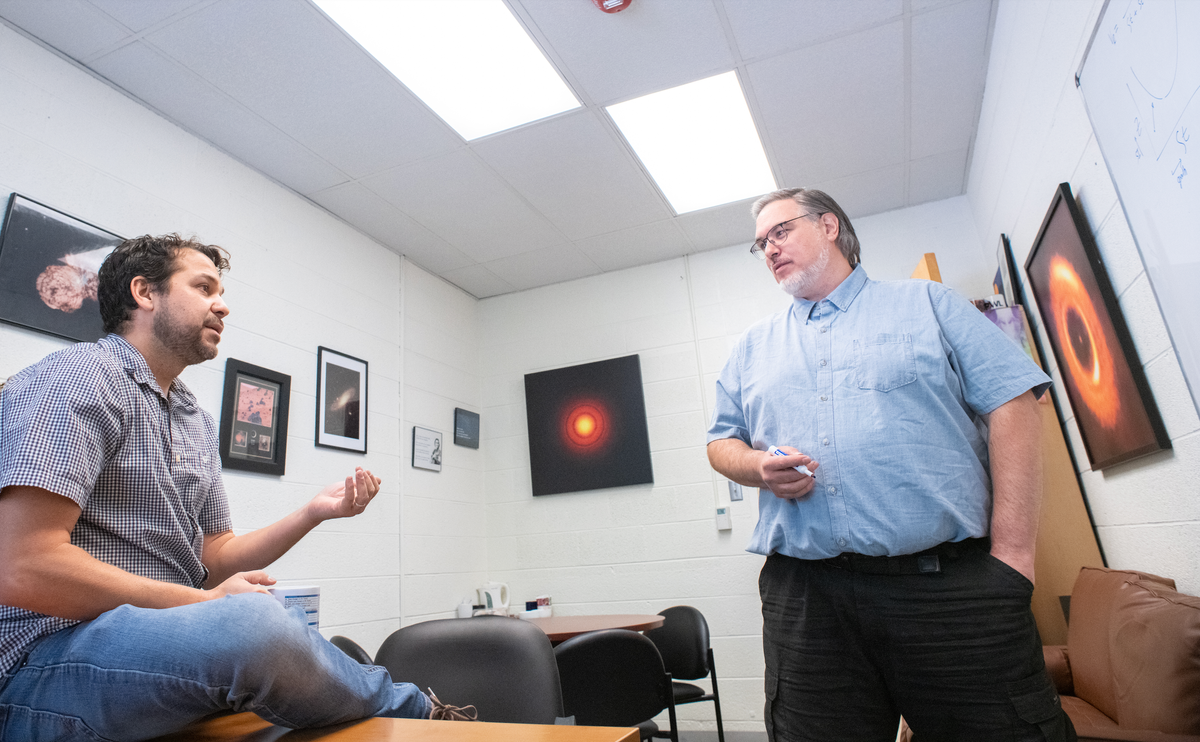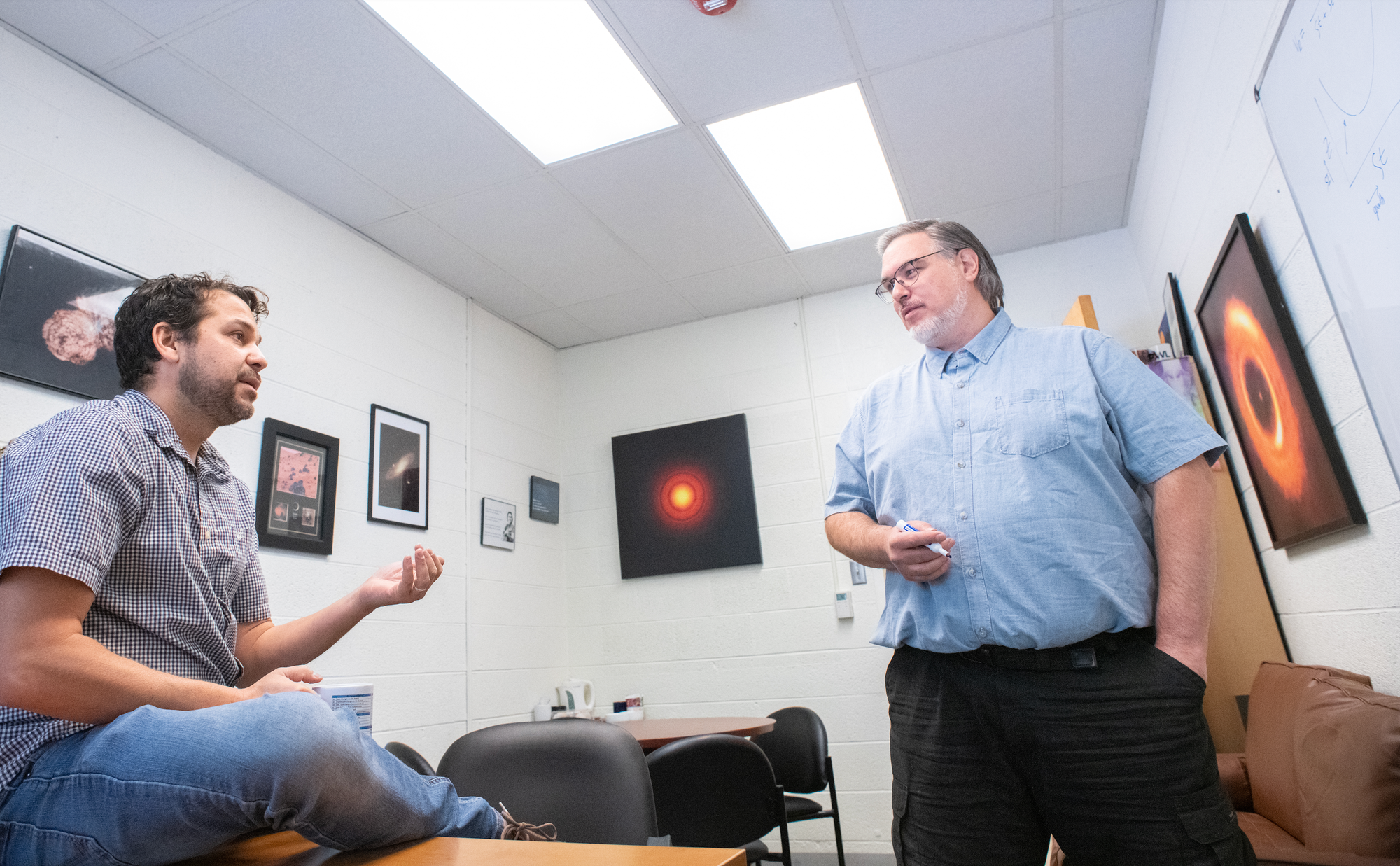NMSU astronomer awarded two NASA grants
NMSU astronomers secure $1M in NASA grants to advance research on planet formation and early solar system mysteries

Minerva Baumann, New Mexico State University
LAS CRUCES - New Mexico State University astronomers Wladimir Lyra and Daniel Carrera have known each other since Carrera began his Ph.D. in Sweden in 2012. Carrera’s adviser was Lyra’s longtime collaborator, Anders Johansen, an astronomy professor at the Lund University in Sweden.
“It's been 12 years, and I've been witness to the excellent work that Daniel has been doing in the field and the impact that he's been having,” said Lyra, an NMSU associate professor in the Department of Astronomy. “After his Ph.D., Daniel did a postdoc at Penn State and then moved to Iowa after that. I was positively surprised and very happy to hear that he was interested in coming here.”
“I came here for a conference Wlad organized in June 2022, and I got to see the place, I met the faculty, I met Jason (Jackiewicz), the department head,” Carrera said. “Honestly, I just fell in love with the city, I fell in love with the department. I knew then I wanted to end up here.”
Carrera came to NMSU as a research assistant professor in the fall 2024 semester with two NASA grants adding up to about $1 million over the next four years. One NASA grant that aims to study formation of planets around other stars is titled “Giant planets in the first million years,” from NASA’s Exoplanet Research Program. The second aims to study the early solar system and is titled “A powerful route to forming planetesimals: Dust growth and the streaming instability," from the NASA Emerging Worlds Program.
The grants will fund Carrera’s research and a graduate student assistant along with two senior scientists, including Lyra.

Lyra’s forte is in the field of planet formation theory. He explained that the field necessitates the use of computational methods. Since they can’t bring stars and planets into the lab, they use computer models to conduct computational experiments.
“The equations of the theory of planet formation are in principle known, but they are what mathematicians call ‘nonlinear,’ which means that there is no known method to solve them without making approximations. In other words, they are too complicated,” Lyra said. “That’s where computers come in handy. Instead of solving the intractable equations with paper and pen, we build a computer model that solves them. The solution is imperfect but accurate enough to understand the behavior of real systems.
“We essentially build in the computers a digital laboratory, perform virtual experiments, and compare the results to the astronomical observations,” Lyra added. “Part of the work Daniel will do is to apply these ideas in order to understand the formation of the first planets in the solar system, and then apply the model to proto-planetary disks to understand the formation of other planets, exoplanetary systems, massive planets, and all of the plethora of planetary and exoplanetary bodies that we see.”
“I want to know where we came from,” Carrera said. “You will find very quickly that the biggest part we don't understand is where the asteroids came from. I divide the formation of the Earth into three steps. When the sun was very young, it was surrounded by a disc of gas and dust, and somehow that dust has become us.”
Step one, Carrera explained, is where very small dust grains can hit each other and as they collide, they become bigger. Step three is once rocks are big enough, they have gravity and can attract materials to grow larger. Once it becomes a rock the size of Las Cruces, it has enough gravity to eventually become a planet. The mystery lies between how small pebbles become rocks the size of Las Cruces.
Carrera wants to add a second concept to the well-researched theory of streaming instability, where gas drag makes small rocks bunch up (similar to a peloton in a bicycle race). If the “peloton” gets dense enough, their collective gravity can make them collapse to be a rock the size of Las Cruces.
"It’s a good idea on paper, but the reality is that the rocks in a real disk are too small for this to work.”
Carrera believes there may be a back-and-forth between this process and “sticking,” or gas drag, that makes rocks bunch up a little, so they can more easily collide and stick together, becoming bigger and bunching up more.
“No one has investigated the two things together. So, I will model the two processes. I’ll model how particles grow together when they hit each other, and also how they form planetesimals because of gas drag. When we investigate how these two work together, maybe they will bridge the remaining gap we need to understand.”
Carrera’s research into the “Giant planets in the first million years,” also funded by NASA, is a different puzzle to solve about how planets formed in our solar system in the first million years. Most research into planet formation has focused much later, when the planet-forming disk is a few million years old. But recent evidence suggests that planets begin to form much earlier than previously thought.
“Whether we like it or not, we have evidence that the universe decided to form planets in the first million years,” Carrera said. “So earlier I said that there are three stages of making planets from dust grains to planetesimals, to Las Cruces-sized rocks to Earth-sized planets. The grant is to study each of those processes, all three of them in context.”
The collaboration with Lyra is what drew Carrera to NMSU, but the community is making it home.
“I came here largely because Wlad is here,” Carrera said. “He's a fantastic scientist. I've known him for about 10 years now. I’ve seen his work.”
Lyra also introduced Carrera to an important New Mexico tradition. When it comes to red or green chile, it turns out Carrera likes both. New Mexicans call that Christmas.
Minerva Baumann writes for New Mexico State University Marketing and Communications and can be reached at 575-646-7566, or by email at mbauma46@nmsu.edu.
